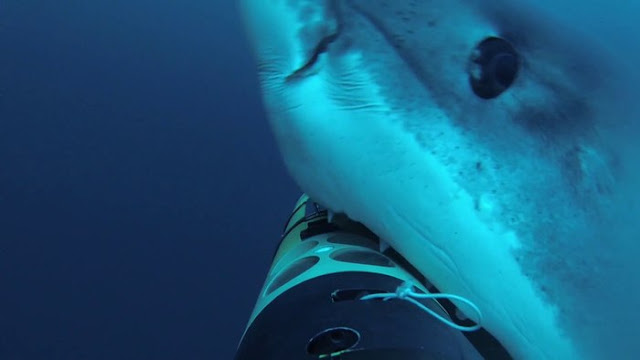It's not easy studying sharks. With most observations being made from the surface we know almost nothing of the predator's behavior below the waves. The REMUS SharkCam AUV and the team at Woods Hole Oceanographic Institute are starting to pierce the blue veil.
"Most of what we know about white shark predatory behavior comes from surface observations," said Greg Skomal, a biologist with the Massachusetts Division of Marine Fisheries. "We have all seen pictures or footage of sharks surging out of the water to capture a seal. But we wanted to find out what was happening at depth – when the sharks swam into the deep, how were these animals behaving? Were they hunting? The REMUS AUV was the perfect tool to do this."
"Most of what we know about white shark predatory behavior comes from surface observations," said Greg Skomal, a biologist with the Massachusetts Division of Marine Fisheries. "We have all seen pictures or footage of sharks surging out of the water to capture a seal. But we wanted to find out what was happening at depth – when the sharks swam into the deep, how were these animals behaving? Were they hunting? The REMUS AUV was the perfect tool to do this."
The observations took place off Guadalupe Island, Mexico in November of 2013 and included the tagging and tracking of four sharks while using the REMUS SharkCam to capture over 13 hours of video at depths up to 100 meters (328 ft).
In addition to the tagged sharks, the SharkCam was also able to document 30 interactions with 10 individual sharks. Behaviors recorded ranged from simple approaches to bumping the vehicle and, on nine occasions, aggressive bites.


The REMUS SharkCam bears the scars of its encounters with multiple great white sharks
The bumps were thought to constitute aggressive behavior consisting of brief physical contact, usually with the shark nudging the vehicle with its snout. The bites were interpreted as predatory behavior by the animal, which usually happened toward the rear of the vehicle.
According to the researchers, this is the first time that deep water predation-type events have been documented. Their findings suggest the sharks take advantage of the clear visibility in the waters off Guadalupe to search for seals and to ambush and disable them by attacking from below, where the shark is concealed in darker water while stalking the seal, which is silhouetted from above.
The 2 m (0.8 ft), 45 kg (100 lb) REMUS AUV represents the state of the art for this kind of research, as well as for more mundane tasks like coastal mapping. The REMUS is capable of 8 hours of autonomous operation and features six REMUS GoPro video cameras providing 360° field-of-view, an omni-directional USBL navigation system, an acoustic communication system (ACOMMS), modem, and transducer, an Acoustic Doppler Current Profiler (ADCP) and a GPS/Wi-Fi/Iridium antenna.
The results of the research have been published in the Journal of Fish Biology. The team plans to continue its research off Guadalupe Island with an improved REMUS that will be capable of longer mission times and dives up to 300 m (984 ft).


No comments